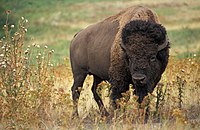
Photo from wikipedia
The Nilgiri Biosphere, being one of the critical catchments, a small agricultural watershed of Udhagamandalam has been analysed to show the need to improve the agriculture by reducing the soil… Click to show full abstract
The Nilgiri Biosphere, being one of the critical catchments, a small agricultural watershed of Udhagamandalam has been analysed to show the need to improve the agriculture by reducing the soil erosion. For this study, the land use and land cover classification was undertaken using Landsat images to highlight the changes that have occurred between 1981 and 2019. The Revised Universal Soil Loss Equation (RUSLE) method and the Geographic Information System (GIS) was used in this study to determine the soil erosion vulnerability of Sillahalla watershed in the Nilgiri Hills in Tamilnadu. This study will help to promote the economic development of the watershed with proper agricultural planning and erosion management. This study focuses on the estimation of the average annual soil loss and to classify the spatial distribution of the soil loss as a map with the RUSLE method and GIS. To estimate the average annual soil loss of the study area, GIS layers of the RUSLE factors like rainfall erosivity (R), soil erodibility (K), slope length and steepness (LS), cover management (C) and conservation practice (P) were computed in a raster data format. The total soil loss and average annual soil loss of the study area for 1981–1990,1991–2000, 2001–2010, 2011–2019 were found to be 0.2, 0.254, 0.3, 0.35 million t/year and 31.33, 37.78, 46.7, 51.89 t/ha/year, respectively. The soil erosion rate is classified into different classes as per the FAO guidelines and this severity classification map was prepared to identify the vulnerable areas.
Journal Title: Soil and Water Research
Year Published: 2021
Link to full text (if available)
Share on Social Media: Sign Up to like & get
recommendations!